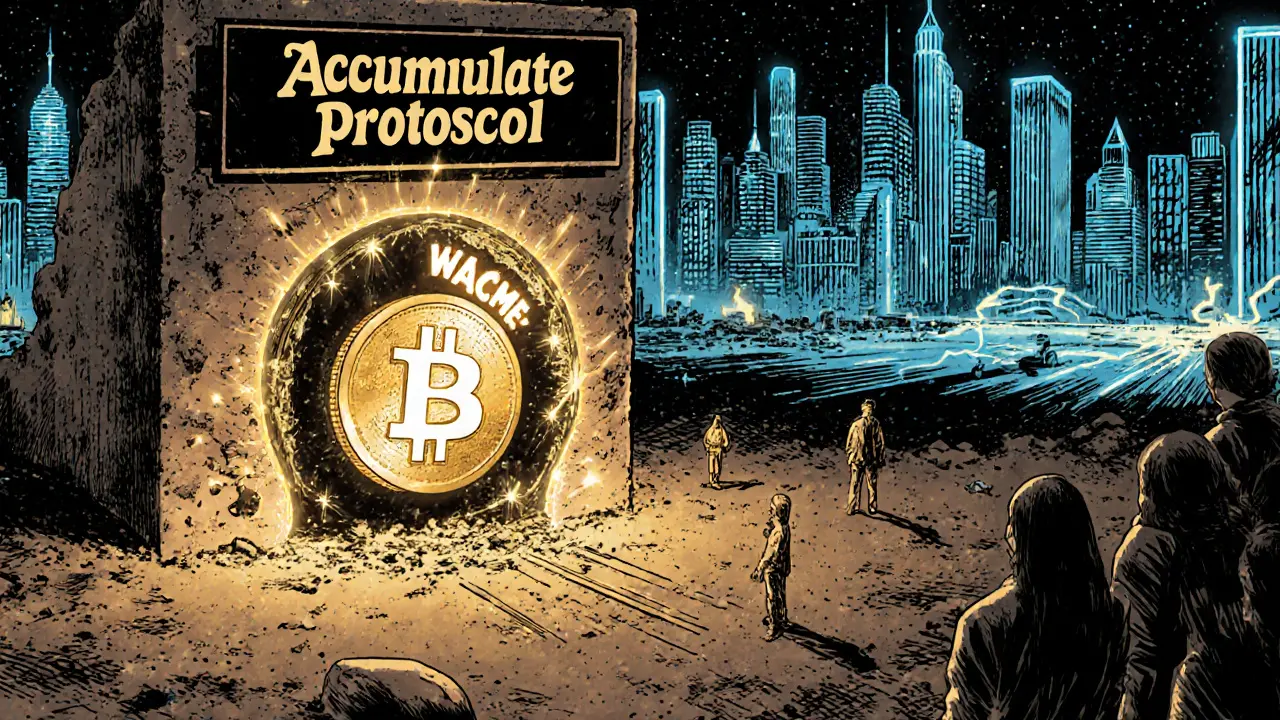
WACME Slippage Calculator
Calculate Your WACME Trade Impact
Based on current market conditions, determine how much slippage you might experience when trading WACME. With only $4,500 daily volume, even small trades can have significant price impact.
Trade Impact Summary
WACME isn’t a new blockchain. It doesn’t have its own network. It doesn’t even have a community of thousands. It’s a digital key - a copy of the ACME token, locked inside a smart contract on Ethereum, designed to let one obscure blockchain talk to the biggest one in crypto. If you’ve heard of WACME, you’re probably wondering: is this just another dead token, or is there something real here?
What Exactly Is Wrapped Accumulate (WACME)?
WACME is an ERC-20 token that represents the native ACME coin from the Accumulate Protocol. Think of it like a voucher. You hand over your real ACME tokens to a digital vault (a smart contract), and in return, you get WACME tokens on Ethereum - each one worth exactly 1 ACME. It’s a bridge. Without it, ACME can’t interact with Uniswap, Aave, or any other Ethereum-based DeFi app. With it, ACME can move into the $1 trillion world of Ethereum DeFi.
The Accumulate Protocol itself launched in October 2022. It’s built on a Delegated Proof of Stake (DPoS) system and focuses on digital identity. It lets users create human-readable addresses like acc://bob.acme and manage keys with enterprise-grade hierarchies. But none of that matters if you can’t use ACME outside its own chain. That’s where WACME comes in.
How WACME Works - The Simple Version
Here’s how it works in practice:
- You own ACME tokens on the Accumulate blockchain.
- You send them to a secure smart contract on Ethereum.
- That contract locks them up - they’re frozen and can’t be spent elsewhere.
- In return, the contract mints an equal amount of WACME tokens and sends them to your Ethereum wallet.
- You now have WACME, which you can trade, stake, or use in DeFi apps on Ethereum.
- To get your ACME back, you burn your WACME, and the contract releases your original ACME.
This 1:1 peg is critical. If WACME ever traded for more than 1 ACME, someone could exploit the system. If it traded for less, people would lose trust. So far, the system holds. But the problem isn’t the tech - it’s the lack of people using it.
The Market Reality: Tiny, Volatile, and Hard to Trade
As of November 10, 2025, WACME trades at around $0.00551. That’s down 96% from its all-time high of $0.1490. Its market cap is just $179,400 - ranked #2262 out of over 25,000 cryptocurrencies. Compare that to wBTC, which sits at $7.2 billion. WACME isn’t just small. It’s microscopic.
Trading volume? About $4,500 per day. That’s less than what some meme coins make in an hour. The main trading pairs are WACME/WETH on Uniswap and PancakeSwap, but even those barely move. If you try to buy $500 worth of WACME, you’ll likely get a 10-15% slippage because there’s not enough liquidity. One Reddit user reported losing 12% on a $500 swap just from price impact.
And the volatility? Daily swings of 4.7% - higher than Bitcoin or Ethereum. That’s not a sign of strength. It’s a sign that a handful of traders are moving the price with small amounts of cash.
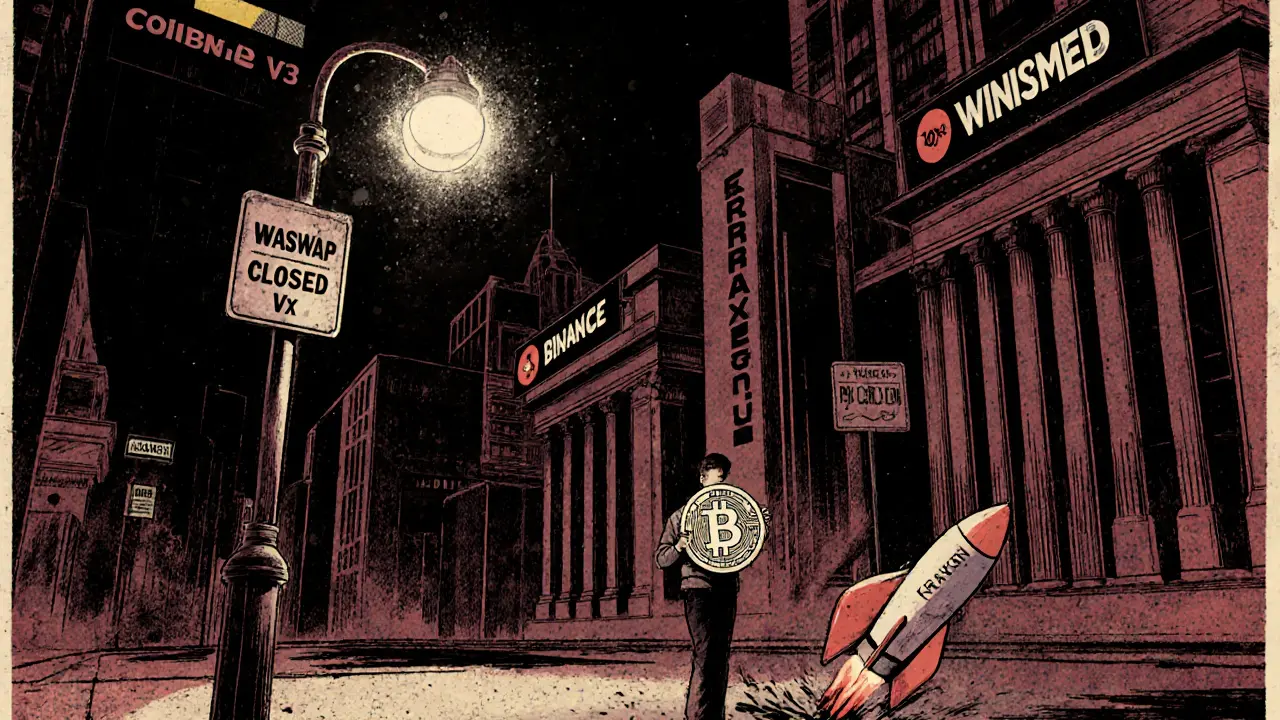
Where Can You Buy WACME? (Spoiler: It’s Not Easy)
You won’t find WACME on Coinbase, Binance, or Kraken. It’s only listed on four decentralized exchanges:
- Uniswap (v3)
- PancakeSwap V3 (Arbitrum)
- MXC
- Curve (Ethereum)
To buy it, you need a Web3 wallet like MetaMask or Trust Wallet. You need to understand gas fees (around $1.20 per transaction on Ethereum), slippage settings, and how to navigate DEX interfaces. For a beginner, this takes 8-12 hours of learning - and that’s before you even find the token.
And even then, it’s risky. Only three wallets fully support WACME. If you use the wrong one, you could lose your tokens. There’s no customer support. No help desk. Just a smart contract and a community of under 1,300 people on Reddit.
Who Is WACME For? (And Who Should Avoid It)
WACME has one real use case: developers building identity-based apps on Ethereum that need to connect to Accumulate’s system. For example, a startup creating a decentralized ID verification tool might use WACME to trigger identity checks on the Accumulate chain. In that narrow scenario, WACME is essential.
But if you’re looking to invest? Hold off. The token’s value is tied to the adoption of the Accumulate Protocol - which has only 1,842 active non-exchange addresses and 2,340 daily transactions. Ethereum does 1.2 million. That’s not a competition. That’s a whisper.
Experts agree. Dr. Elena Rodriguez, author of Cross-Chain Communication Protocols, says WACME is technically sound but solves a problem too few people care about. Delphi Digital’s Michael Chen adds that only 0.3% of enterprise blockchain projects in 2025 used identity-specific chains. The market is moving toward Ethereum-compatible solutions - not niche protocols.
The Bigger Picture: Why Identity Blockchains Struggle
The global digital identity market is set to hit $28.5 billion by 2027. But blockchain-based identity? Just 4.7% of that. And within that tiny slice, Accumulate holds less than 1% market share. Competitors like Civic (CVC) and SelfKey (KEY) have market caps 1,000x larger. They’re listed on major exchanges. They have developer docs. They have teams.
Accumulate’s GitHub has only 287 stars and 43 open issues. The documentation covers only 42% of WACME integration details. Developers who’ve tried it say it works - if you can figure out the missing pieces. One GitHub user wrote: “It worked flawlessly once we navigated the sparse documentation.” That’s not a product. That’s a puzzle.
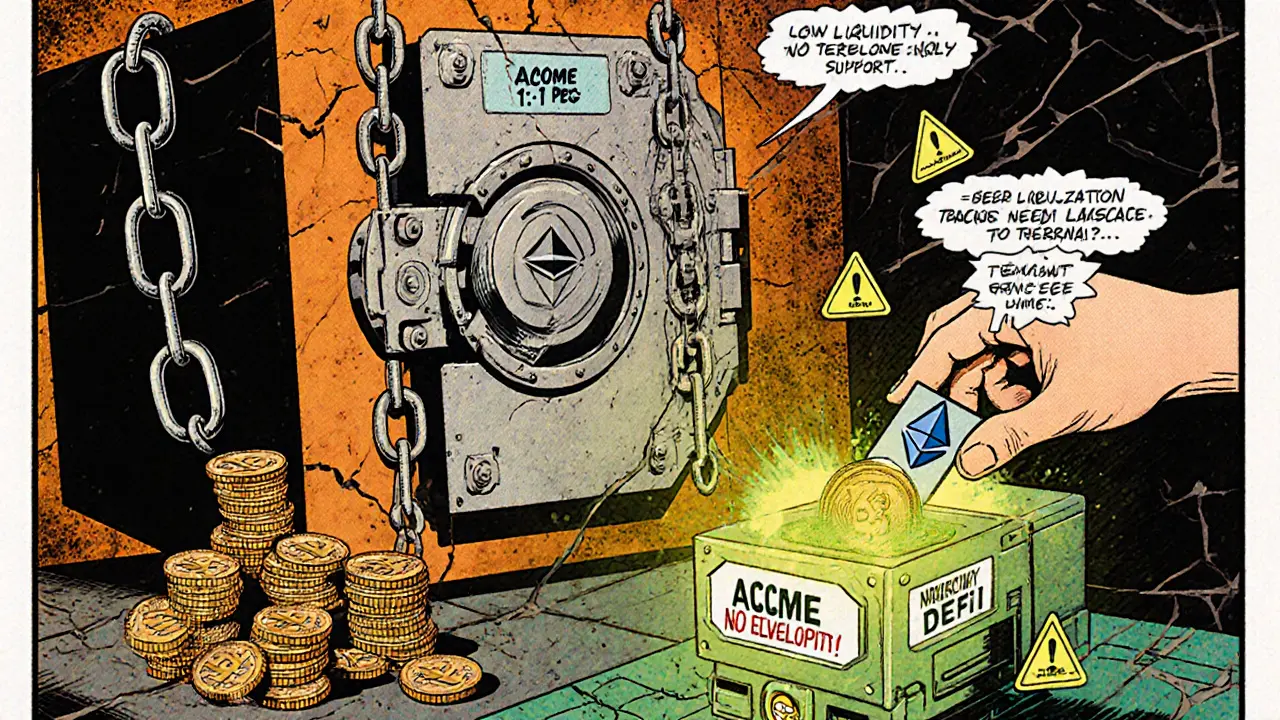
Is WACME a Scam? (No. But It’s Not Safe Either)
There’s no evidence of fraud. The smart contracts have been audited. The wrapping mechanism follows standard practices. The team hasn’t rug-pulled. But that doesn’t make it safe.
Low liquidity = high risk of manipulation. Sharpe AI’s security report flagged WACME as vulnerable to price swings from small buy/sell orders. If someone dumps 10 million WACME tokens, the price could crash 80% in minutes. And there’s no safety net. No insurance. No exchange backing. Just you and a contract.
The SEC’s 2024 guidance on wrapped tokens adds another layer of uncertainty. If regulators decide WACME is a security (because it’s tied to a private blockchain’s utility), trading it could become illegal in the U.S. That’s not speculation - it’s a real legal gray zone.
What’s Next for WACME?
The Accumulate team released version 2.3.1 in October 2025, improving cross-chain efficiency by 37%. They’ve also announced plans to integrate with Polygon ID and expand to other EVM chains in Q1 2026. But there’s no timeline. No funding update. No major partnerships.
Twelve crypto research firms gave WACME only a 28% chance of surviving past 2027. JPMorgan’s team says identity protocols need enterprise deals to survive - and Accumulate has none. On the other hand, independent analyst Alex Mashinsky believes if Accumulate lands a key government or financial partner in 2026, it could pivot.
Right now? It’s a gamble. Not a bad one - but not a smart one either.
Final Take: WACME Is a Tool, Not an Investment
WACME isn’t meant to be held. It’s meant to be used - by developers, not speculators. If you’re building an app that needs identity verification on Ethereum, and you’re committed to the Accumulate Protocol, then WACME is necessary. It’s a bridge. Use it. Move through it. Then move on.
If you’re looking to buy WACME because you think it’ll go up 10x? You’re betting on a project with no users, no liquidity, and no clear path to growth. The math doesn’t add up. The market has already voted. And it’s not interested.
WACME exists. It works. But it’s a ghost in the machine - a digital echo of a blockchain few people know, used by even fewer. Don’t ignore it. Don’t chase it. Understand it - and then decide if it’s worth your time.
Is WACME a real cryptocurrency?
Yes, WACME is a real ERC-20 token backed 1:1 by ACME from the Accumulate Protocol. It’s not a scam - the smart contracts are audited and the wrapping mechanism is standard. But it’s not a mainstream crypto. It has no exchange listings, minimal liquidity, and almost no community. It exists to serve a specific technical need, not as a speculative asset.
Can I buy WACME on Coinbase or Binance?
No, you cannot buy WACME on Coinbase, Binance, or any centralized exchange. It’s only available on four decentralized exchanges: Uniswap v3, PancakeSwap V3 (Arbitrum), MXC, and Curve. You’ll need a Web3 wallet like MetaMask and a basic understanding of DEX trading to purchase it.
Why is WACME’s price dropping so much?
WACME’s price has fallen over 96% from its all-time high because the Accumulate Protocol has seen almost no adoption. With only 1,842 active non-exchange addresses and $4,500 in daily trading volume, there’s no demand to support the price. The token’s value is tied entirely to the success of a niche blockchain that hasn’t gained traction in a market dominated by Ethereum and Bitcoin.
Is WACME safe to use?
Technically, yes - the smart contracts have been audited and show no vulnerabilities. But safety isn’t just about code. The extreme lack of liquidity makes WACME vulnerable to price manipulation. A small sell order can crash the price. Also, only three wallets fully support it. If you send WACME to the wrong wallet, you could lose it permanently. Only use it if you understand the risks.
What’s the point of WACME if no one uses it?
The point is to enable interoperability. WACME lets the Accumulate Protocol’s identity features - like human-readable addresses and key hierarchies - be used inside Ethereum DeFi apps. But without developers building those apps, WACME has no purpose. Right now, there’s almost no demand. It’s like having a key to a door that no one built.
Should I invest in WACME?
No, not as an investment. WACME has a market cap under $200K, daily volume under $5K, and no clear path to growth. It’s not a store of value, not a speculative play, and not a portfolio asset. It’s a utility token for a niche protocol with minimal adoption. If you’re a developer needing to integrate Accumulate’s identity system into Ethereum, then use WACME. Otherwise, avoid it.



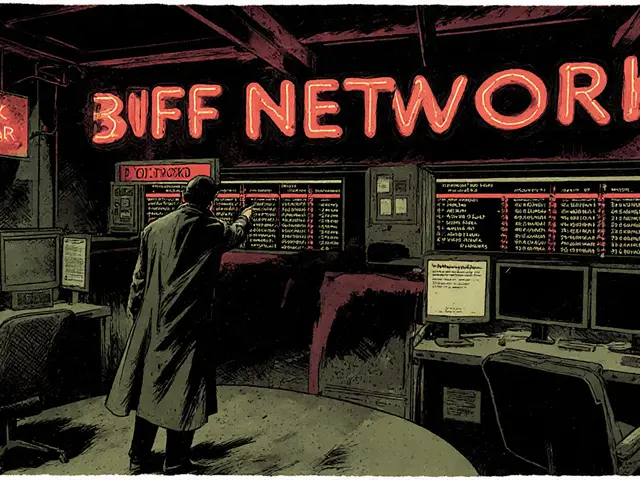
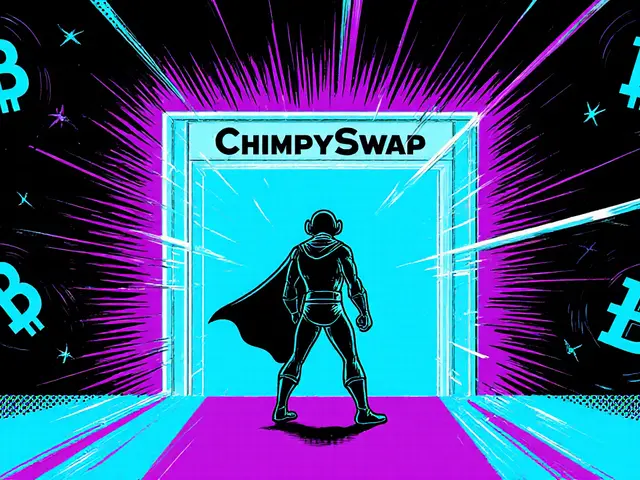

There are 8 Comments
Michelle Stockman
WACME? More like WASTED. 😒
Pranjali Dattatraya Upadhye
Okay, but imagine if this was the key to unlocking digital identity on Ethereum… like, literally, a bridge to a whole new way of proving who you are online? 🤔 I mean, yeah, it’s tiny now-but what if it’s the quiet seed of something huge? Not everything that starts small stays small. Just saying.
John Doe
They’re lying. This is a FedCoin shill. They’re testing crypto surveillance tools under the guise of ‘identity.’ I’ve seen the pattern-tiny token, zero volume, audited contracts… classic setup. They want to track your wallet movements under the banner of ‘decentralized identity.’ Wake up.
Whitney Fleras
It’s interesting how the article frames this as a tool-not an investment. That’s actually the healthiest way to look at most DeFi bridges. You don’t buy a hammer to sell it later-you buy it because you’re building something. If you’re not building, maybe don’t touch WACME.
Cydney Proctor
Oh wow, a token with less liquidity than my last Tinder date’s emotional availability. Truly groundbreaking. I’m sure the 1,300 Reddit users are just dying to explain to me why this isn’t a scam. 🙄
Benjamin Jackson
I get the skepticism-but I also get the quiet hope. There’s something beautiful about a project that doesn’t scream for attention, just quietly does its job. Maybe WACME won’t make anyone rich. But if it helps one dev build a better, more private way to verify identity? That’s worth something.
Louise Watson
No exchange listings. Tiny volume. Hard to use. Sounds like a trap.
Liam Workman
WACME is like that one friend who’s brilliant but never leaves their room. They’ve got all the ideas, the logic, the talent-but no one’s invited them to the party. And honestly? The party’s not even looking for them. But… what if one day someone knocks? 🤞
Write a comment
Your email address will not be published. Required fields are marked *